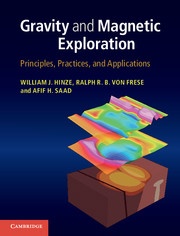Book contents
- Frontmatter
- Dedication
- Contents
- Preface
- Acknowledgements
- 1 Introduction
- Part I Gravity exploration
- 2 The gravity method
- 3 Gravity potential theory
- 4 Density of Earth materials
- 5 Gravity data acquisition
- 6 Gravity data processing
- 7 Gravity anomaly interpretation
- Part II Magnetic exploration
- Part III Applications
- Appendix A Data systems processing
- References
- Index
4 - Density of Earth materials
from Part I - Gravity exploration
Published online by Cambridge University Press: 05 May 2013
- Frontmatter
- Dedication
- Contents
- Preface
- Acknowledgements
- 1 Introduction
- Part I Gravity exploration
- 2 The gravity method
- 3 Gravity potential theory
- 4 Density of Earth materials
- 5 Gravity data acquisition
- 6 Gravity data processing
- 7 Gravity anomaly interpretation
- Part II Magnetic exploration
- Part III Applications
- Appendix A Data systems processing
- References
- Index
Summary
Overview
The gravity method measures horizontal spatial changes in the gravitational field that result from mass differentials which in turn are controlled by the volume and contrasting densities of anomalous masses. As a result, an understanding of the density of Earth materials is essential in planning surveys as well as in interpreting gravity anomalies.
Density is a function of the mineral composition of Earth materials as well as their void volume and the material filling the voids. As a result, densities of rocks can be estimated by considering their origin and the processes that subsequently have acted upon them. However, it is advisable to measure densities either directly or indirectly wherever possible, preferably in situ, because of the difficulties in obtaining samples that are representative of the actual geological setting. In situ measurements may be obtained from the relationship of gravity anomalies to topography or determined indirectly from correlative measurements such as seismic wave velocity or attenuation of gamma rays.
Introduction
Knowledge of germane Earth material densities within a study region is required for effective planning and implementation of gravity surveys. Accordingly, as an introduction to the gravity method, the sections below describe the fundamentals of this property and the controls on it, together with methods of determining density. Representative values are presented of the density of a variety of Earth materials including igneous, metamorphic, and sedimentary rocks, sediments, and soils to aid the explorationist in the use of the gravity method.
- Type
- Chapter
- Information
- Gravity and Magnetic ExplorationPrinciples, Practices, and Applications, pp. 64 - 87Publisher: Cambridge University PressPrint publication year: 2013



